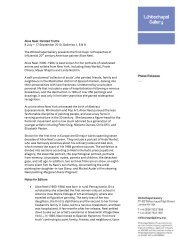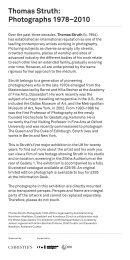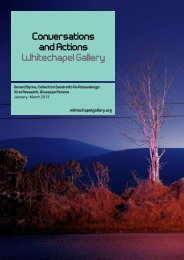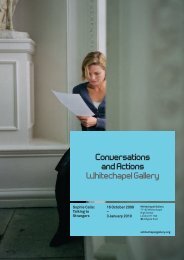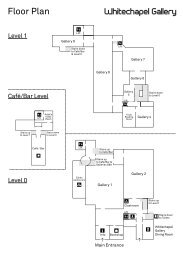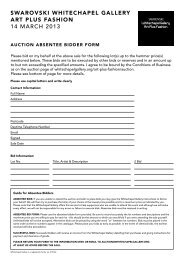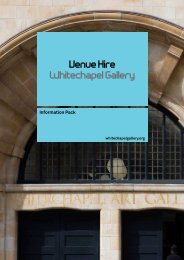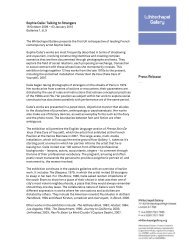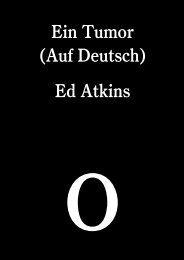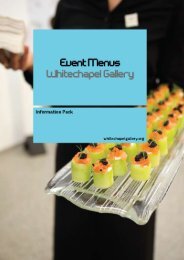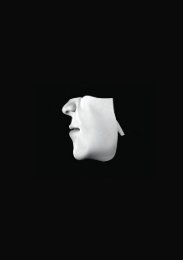Beatriz Milhazes Screenprints 1996–2011 Family Activity Sheet
Beatriz Milhazes Screenprints 1996–2011 Family Activity Sheet
Beatriz Milhazes Screenprints 1996–2011 Family Activity Sheet
- No tags were found...
Create successful ePaper yourself
Turn your PDF publications into a flip-book with our unique Google optimized e-Paper software.
<strong>Beatriz</strong> <strong>Milhazes</strong><strong>Screenprints</strong> 1996–2011<strong>Family</strong> <strong>Activity</strong> <strong>Sheet</strong>The Gallery at Windsor,Vero Beach, Floridawhitechapelgallery.org/education<strong>Beatriz</strong> <strong>Milhazes</strong> Havai (Hawaii), 2003, Multi-coloured screenprint on Waterford 638g paper, 131.5 x 16cm.© The Artist and Stephen Friedman Gallery, London
<strong>Beatriz</strong> <strong>Milhazes</strong> <strong>Screenprints</strong> 1996–2011The Gallery at Windsor, Vero Beach, FloridaThis <strong>Activity</strong> <strong>Sheet</strong> suggests different ways of looking at and talking about the exhibition <strong>Beatriz</strong><strong>Milhazes</strong> <strong>Screenprints</strong> 1996-2011, including ideas for how to make artworks inspired by <strong>Milhazes</strong>’prints, using objects from everyday life and some basic art materials.Before you start...We think a great way to visit an exhibition is with a friend or someone in your family, writing orsketching your thoughts and reactions to the work together, and if you have time, making your ownwork at the gallery or at home inspired by what you’ve seen and talked about.<strong>Beatriz</strong> <strong>Milhazes</strong>, Canela (Cinnamon), 2010
<strong>Beatriz</strong> <strong>Milhazes</strong> makes her own books...Here’s how to make your own book:1.2.3.• Fold an A3 sheet in half, fold it in halfagain and once again (so that it is 1/8the size of the sheet).Fold 8 rectanglesCut through centralpanels or fold andcut as shownFold landscape horizontal• Unfold completely and fold once inthe opposite direction widthways.Cut into one of the spines of thefolded sheet on one side as far asthe middle.4.5.6.• Open up the sheet (there is now a slitin the middle of the page).Fold it in half lengthways.Push left and rightends to centre toform a cubeThen cross...Fold around any twosections to make a sixpage origami book• Hold it upright with the slit at thetop and push the edges towards themiddle, bringing all the pages of yournotebook together. Your book is ready!<strong>Beatriz</strong> <strong>Milhazes</strong> was born in 1960 in Rio de Janeiro, Brazil and still lives and works there, where thenature and beauty of Rio continue to inspire her work. The artist has a special way of making printsusing sheets of plastic and glue to place the paint on the canvas.Talk to someone in the Gallery to find out more!<strong>Beatriz</strong> <strong>Milhazes</strong>, Noite de verao (Summer Night), 2006
Colour<strong>Beatriz</strong> <strong>Milhazes</strong>’ prints are full of bright, dancing colours that jump out of the canvas, inspired bycolours in the natural and manmade world around her... what are your favourite colours in the artist’swork? What colours do you not like?What colours do you notice around you in your world?Which ones would you choose to include in a work of art?Mini-activity: Personal PaletteMaterials: coloured pencils/crayons/oil pastels/sharpies• Choose 5 colours that you think would look good together.• Make your own palette in your notebook with these colours using pencil/ crayon/ pastels.ShapesThe artist’s prints are full of different shapes including lots of circles, hearts and arabesques thatdon’t describe anything in particular, but might make you think of other things in the world aroundyou – even animals! <strong>Beatriz</strong> <strong>Milhazes</strong> is inspired by lots of things including flowers & plants, clothes& jewellery, cars & buildings… Look closely; what shapes do you see in the prints, and what do theseshapes make you think of? Can you find any spider’s webs?!Left - Right:<strong>Beatriz</strong> <strong>Milhazes</strong>, Rosa branca no centro (White Rose in Center), 1997<strong>Beatriz</strong> <strong>Milhazes</strong>, Entre o mar e a montanha (Between the Ocean and the Mountains), 1997–98<strong>Beatriz</strong> <strong>Milhazes</strong>, No campo (On the Land), 1997
Mini <strong>Activity</strong>: Signature ShapeMaterials: coloured pencils/ crayons/ oil pastels/ sharpies; colourful tracing paper and thick card,scissors, pieces of sponge or foam, paint; found materials (see below)• Trace or draw some shapes that you like in your notebook. They could be shapes from the artist’swork, or something you find outside the gallery (flowers, leaves, shells, feathers, stones).• Choose one of the shapes, make a stencil from it (by cutting the shape out of hard card) or cut theshape out of a sponge.• Repeat your shape, using the stencil or the sponge (with paint), as many times as you like.. now youhave your own signature wallpaper design!More <strong>Activity</strong>If you want to explore printmaking further, you could use materials such as wood (or even potatoes!) tocut your shape into and make more wallpaper. You will need a sharp tool to do this, so make sure there’san adult with you at all times!<strong>Beatriz</strong> <strong>Milhazes</strong>, Uva Selvagem (Wild Grape), 1996-98
Inspiration<strong>Beatriz</strong> <strong>Milhazes</strong> is influenced by the colours and shapes from the tropical rainforest landscapearound her in Rio, but also by music (especially ‘Bossa nova’!) and carnivals. What’s your favourite typeof music? If you were to describe your favourite song using colour and shape, what would it look like?<strong>Activity</strong>: What’s your Bossa nova?• Sing your favourite song or type of music (to yourself or out loud!).• In your notebook, draw what you think its rhythm and overall sound looks like, using the colours andshapes you’ve been putting in your notebook already.• If you have time, write the words of the song on the opposite page.<strong>Beatriz</strong> <strong>Milhazes</strong>, O pato (The Duck), 1996-98
The Big <strong>Activity</strong>:Useful materials:A3 paper, coloured pencils/ crayons/ oil pastels/ sharpies, small A5 sheets of colourful tracing paperand hard card, scissors, pieces of sponge or foam, glue, paint, (wall)paper with different patterns,doilies, pieces of lace and/ or floral fabrics, glitter, found natural materials from outdoors (flowers,leaves, shells, feathers, stones).Bring together all of the things you found out about <strong>Beatriz</strong> <strong>Milhazes</strong>’ artwork to make a big work ofyour own full of your favourite colours, shapes and inspired by the natural world around you, or by themanmade fabric and paper that have been provided.• Think about where you live and what you like or don’t like about it, and let this lead your collage.• Start from the centre of the page and work out from it in different directions.• Try repeating shapes to make patterns, and don’t worry about putting things on top of each other!• Remember to use all the space on the page too, just like <strong>Beatriz</strong> <strong>Milhazes</strong>...Now you have your own Artist’s Book. Write a description of your collage in your book!GlossaryArabesque: a type of decoration influenced by natural forms like plantsCanvas: fabric painting surface stretched across a wooden framePrint: one copy of many copies of an artwork made by placing ink on paper in different waysPalette: a range of colours that you can dip intoInspiration: where ideas come fromSignature: what makes something the only one of its kindBossa nova: a style of Brazilian music from the 1960sCollage: an artwork using lots if different kinds of materials togetherWritten by the Whitechapel Gallery’s Education Department.To find out more about the Whitechapel Gallery’s, please seewhitechapelgallery.org



